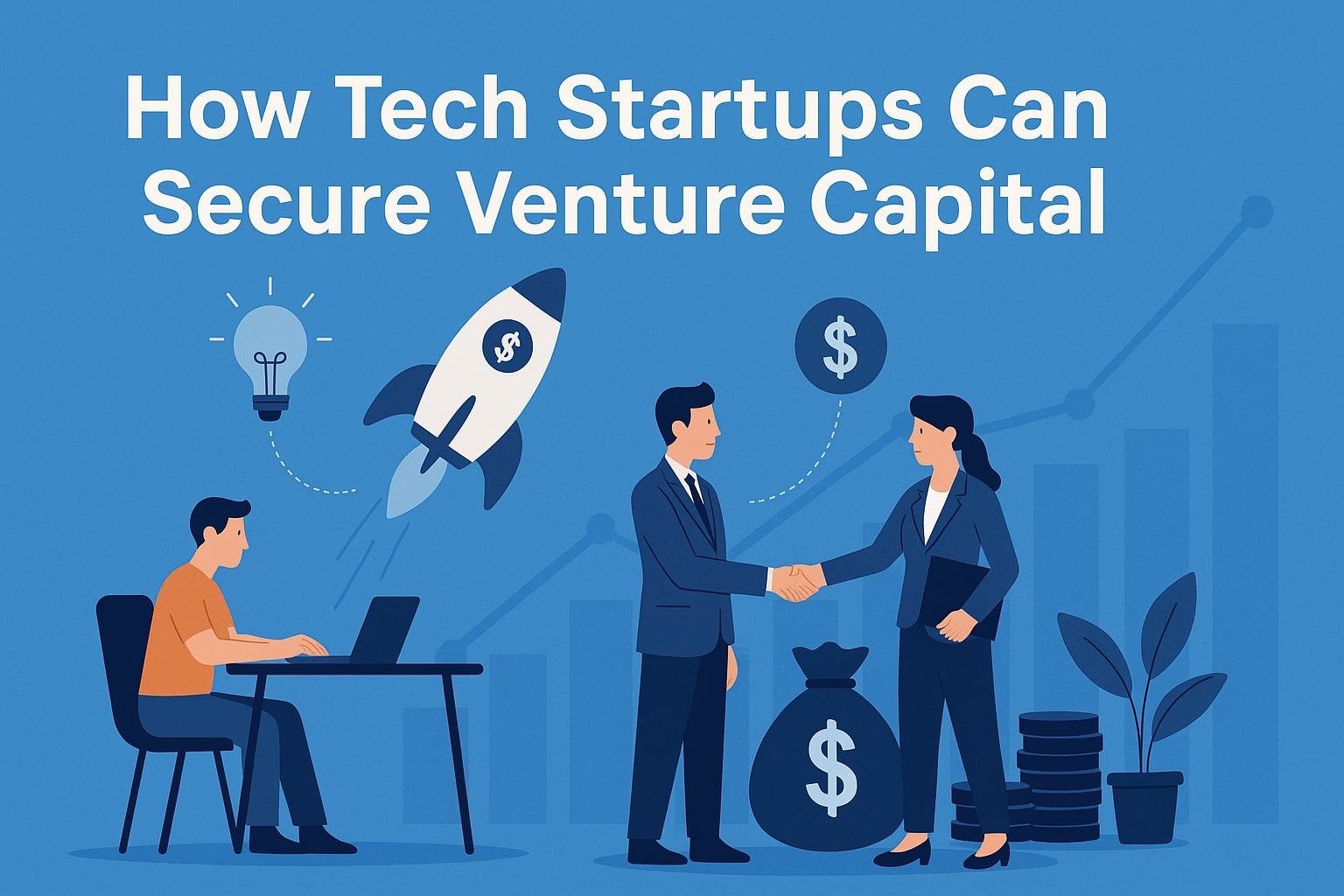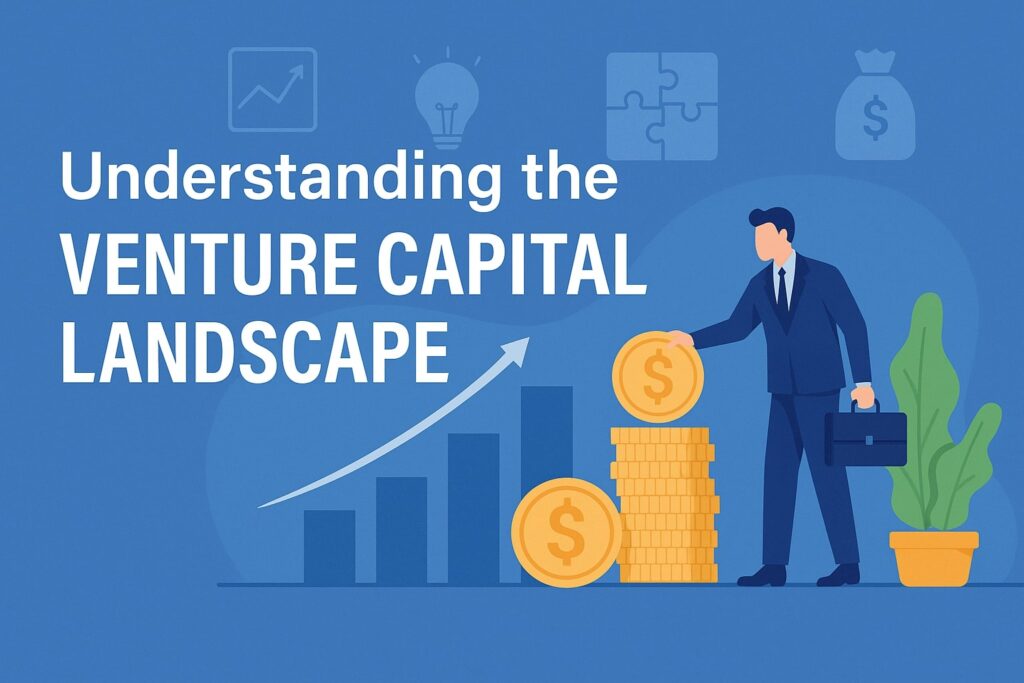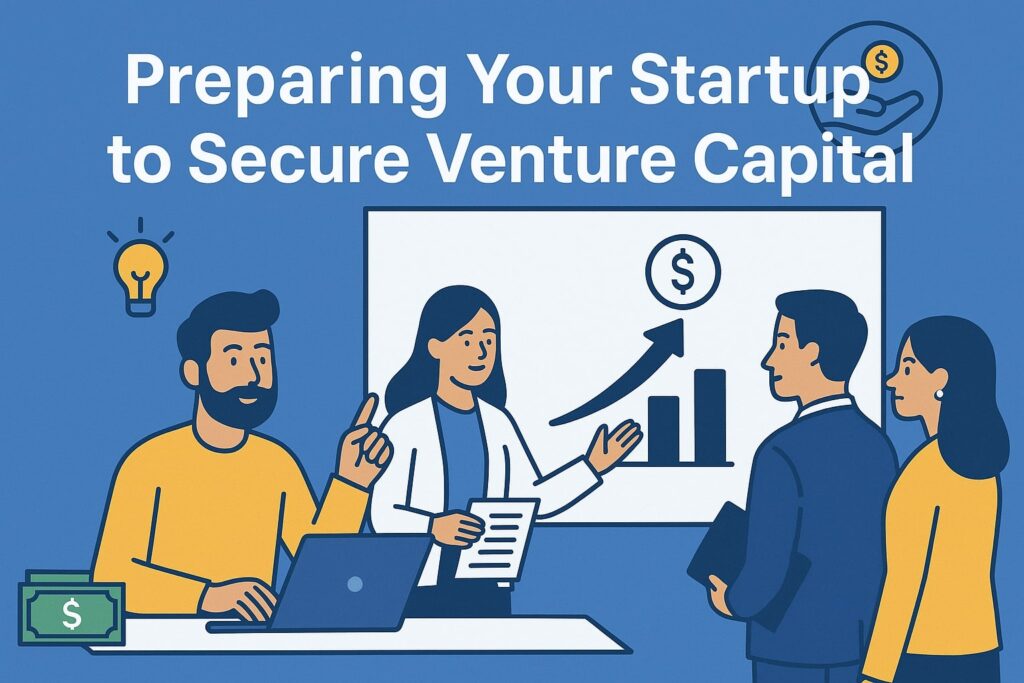
How Tech Startups Can Secure Venture Capital
A startup founder preparing a funding strategy and pitch deck to secure venture capital. Early-stage tech entrepreneurs in the USA face a challenging fundraising landscape.
Venture capital (VC) offers growth capital for high-potential startups, but competition is fierce: only about 0.05% of startups actually secure VC funding. In 2023 U.S. venture firms invested around $330 billion, yet most founders never reach a term sheet.
To secure venture capital, founders must fully understand what investors look for and systematically prepare their business and pitch. This guide explains the VC process for U.S. tech startups, covering strategy, preparation, and key success factors.
Understanding the Venture Capital Landscape

Global venture capital investment by stage (2019–2024). Funding spiked around 2021 and has since cooled; the U.S. now captures the majority of funding. Venture capital is equity investment in private companies.
Unlike loans, VC provides cash in exchange for an ownership stake. VCs typically invest in high-growth sectors (notably software, AI, biotech, etc.) and expect large returns. In 2025 the U.S. accounted for about 64% of global VC funding, reflecting its deep startup ecosystem.
The global VC market has cooled since its 2021 peak – for example a report shows quarterly funding fell from ~$196B in late 2021 to ~$109B by Q2 2025 – but the U.S. still leads. Notably, software and AI companies now account for roughly 45% of VC investments.
Within the U.S., capital is concentrated in a few hubs. California continued to lead with over 4,000 deals ($81.6B in 2023) – roughly four times the value in New York. Massachusetts and Texas also rank high, reflecting Boston’s life-science scene and Texas’s growing tech hubs.
However, fast-growing ecosystems (Florida, Colorado, etc.) are attracting more deals. Early-stage founders should be aware of these regional dynamics (e.g. Silicon Valley and NYC VCs heavily fund local tech), and consider relocation or virtual pitching accordingly.
Despite fluctuations, venture capital remains a key source of growth funding for tech startups in the U.S. VCs not only supply cash but also mentoring, industry connections, and credibility. In return, investors take higher risk for potentially outsized returns.
For founders, securing VC means giving up equity and some control, but it can be vital for scaling rapidly. Below we outline how a tech startup can prepare and pitch itself to attract VC funding, from seed rounds through later stages.
Preparing Your Startup to Secure Venture Capital

Before approaching investors, a tech startup must build a solid foundation. This includes having a working product (or prototype), early customer validation, and a core team.
Key factors VCs evaluate include market opportunity, team quality, traction, and scalability. In practice, founders should ensure they can demonstrate:
- Large market opportunity. VCs invest in big markets because they want the chance of high returns. In fact, 88% of investors say market size is the most important factor for early-stage deals.
Founders should clearly define their Total Addressable Market (TAM) and show realistic plans to capture a significant share. - Strong founding team. Venture capitalists bet on people as much as ideas. Studies indicate 92% of VCs rank the founding team as the top criterion.
The team should combine domain expertise (e.g. tech backgrounds), business skills, and a track record of execution. Complementary technical and business skills among co-founders are highly valued. - Product-market fit and traction. Startups must solve a real problem that customers are willing to pay for. Strong product-market fit means you have evidence of demand – such as users, pilot customers, or early revenues.
Companies with clear fit grow much faster: one analysis found firms with strong market fit grow revenue 20–30% faster than those still searching. Gather any metrics or feedback that show you’re on track (user growth, pipeline leads, etc.). - Scalable business model. Tech startups should present a model that can grow rapidly without linear cost increases.
VCs want to see how revenue can expand across geographies or customer segments. Demonstrating a path to profitability or clear unit economics helps, even if profits are far off.
To prepare these elements, founders often start by writing a robust business plan and creating a pitch deck (see below). They may also leverage incubator or accelerator programs.
Incubators provide coworking space and mentorship, while accelerators offer structured programs culminating in a demo day. Both can help refine the startup and often introduce founders to investor networks.
(For example, accelerator demo days give startups a platform to present directly to multiple investors at once.) Early traction – even from pilots or small deals – and participating in startup competitions or tech events can also raise a profile.
Key Preparations for Raising VC
- Finalize your legal structure. In the U.S., most VCs expect a C-Corp (usually Delaware). Ensure all incorporation, cap table, and founder agreements are in order.
- Protect intellectual property. If relevant, file for patents or secure trade secrets before pitching. IP can significantly increase a tech startup’s value.
- Build a minimum viable product (MVP). Even a prototype or limited beta proves your concept works. Use any alpha users or beta testers to show interest.
- Assemble a complete pitch deck and business plan. These documents will communicate your vision, strategy, and financials (see next section).
- Set measurable goals. Have clear milestones for growth, technology development, or customer acquisition. Demonstrating planned milestones reassures investors.
Carefully preparing these aspects greatly improves credibility. Once ready, the startup can begin targeting appropriate investors.
Building a Compelling Pitch Deck

A concise, well-designed pitch deck is crucial for making a strong first impression. Investors may spend only a few minutes reviewing your slides, so clarity and focus are essential. An effective deck typically covers 6–10 slides (some use up to 15) that tell a story. Key elements include:
- Problem & Solution: Clearly explain the pain point your startup solves and how your product/service addresses it.
- Market Opportunity: Quantify the market size (TAM) and growth trends. Use data or diagrams (e.g. TAM/SAM/SOM) to justify the opportunity.
- Business Model & Traction: Explain how you will make money (pricing model, sales channels) and share any traction (users, revenue, pilot customers).
- Go-to-Market Strategy: Outline marketing and sales plans: how you will reach customers and scale adoption.
- Team: Highlight the founders’ backgrounds and any key hires. Emphasize relevant experience or domain expertise.
- Financials: Provide a summary of projections, burn rate, and funding needs. Include realistic forecasts for 3–5 years.
- Vision & Call to Action: State your long-term vision and specify the ask (how much capital you are seeking and proposed use).
For example, Silicon Valley Bank advises that a startup deck should at minimum “clearly articulate your company’s mission, the problem you are solving, your solution, the market opportunity, your team and financial projections”.
It should also be tailored to your audience: if you have technical founders, briefly note their expertise to build confidence. Use simple, engaging visuals and keep text minimal. Remember the deck’s purpose is to spark interest and secure a meeting, not to close a deal on its own.
When designing slides, follow these best practices: keep formatting clean, use graphics or charts for key data (like market size), and make sure the narrative flows logically. Be honest about challenges and how you’ll overcome them; VCs appreciate candor.
Once your deck is polished, practice pitching it succinctly. This preparation will help you confidently present to investors when the opportunity arises.
Finding the Right Venture Capital Investors

Not all VCs are the same. Finding the right investors – ones who fund your stage, industry, and geography – is crucial to securing venture capital efficiently. Avoid the common mistake of cold-emailing random investors. Instead, do thorough research:
- Target matching firms. Use startup databases or networks (e.g. Crunchbase, Visible Connect) to identify firms that have invested in similar tech or stage companies.
For example, if you’re raising a $1M seed round, focus on seed-stage funds, not those doing $50M Series B checks. Each VC typically lists industry focus and check sizes on their website. - Leverage networks and introductions. Warm introductions are far more effective than cold outreach. Tap your personal network (angel groups, startup meetups, LinkedIn) to find mutual connections to investors.
Ask mentors, professors, or entrepreneurs you know for referrals. Incubators can also make investor intros during demo days or mentors’ networks. - Attend events and pitch sessions. Participate in tech conferences, startup fairs, and pitch competitions, especially those with investor attendance. These are opportunities to make face-to-face connections and schedule meetings.
Keep updated lists of VC events in tech hubs (e.g. Silicon Valley, NYC, Austin) and apply for any startup showcases. - Screen and prioritize. Even after identifying potential VCs, narrow them down. Check how recently a fund was raised (older funds may be slow to invest).
Consider location preferences – some firms invest only domestically or in certain regions. Focus first on those where the fit is highest.
By targeting the right investors and building early relationships, you greatly improve your chances. Remember, investors invest in founders, so demonstrating alignment with their interests (market, stage, thesis) is key.
Networking, Incubators and Relationship-Building
Networking is as important as product development when fundraising. Start building investor relationships long before you need the money. Regular communication and outreach can make investors familiar with your startup and more likely to invest when you officially raise. Useful strategies include:
- Early updates: Keep a list of interested VCs and send periodic business updates (monthly/quarterly). Include key milestones, metrics, or press mentions. Tools like Visible can help craft investor reports.
Providing consistent, data-driven updates positions you as a diligent founder and keeps investors engaged. - Seek advice, not funding, at first: Invite potential investors for informal feedback on specific challenges (hiring, market strategy, etc.). Many investors appreciate this and may become future champions. Over time, these advisors may invest or introduce you when you launch a round.
- Demo days and product launches: If you are part of an accelerator or incubator, take advantage of the final demo day. If not, invite investors to any product launch or tech demo you host.
Seeing your product live can excite them and provide talking points. Follow up promptly after events to keep the conversation going.
Founders who build rapport early report that it makes fundraising easier. As one expert notes, it is “easier to ask for an investment from someone who has already been following your company’s journey”.
In short, view fundraising as a sales process: identify leads, nurture the relationship, and close when ready. Personal connections and persistence often make the difference between cold rejection and a signed term sheet.
Common Pitfalls to Avoid
When seeking venture funding, avoid these common mistakes:
- Over-valuing the company. Setting an unrealistically high valuation can scare away investors. While you want a high cap, VCs will scrutinize your numbers and market to justify it. Use industry benchmarks and realistic projections.
- Targeting mismatched investors. Approaching firms outside your industry or stage wastes time. Each VC has specific focus areas; if they don’t invest in your sector or round size, they won’t bite. Always tailor your outreach list to firms whose portfolios and fund mandates align with your startup.
- Neglecting an exit strategy. Investors want a return, so they care about how they will eventually cash out. Failing to mention potential exit paths (IPO, acquisition, etc.) can be a red flag. Even if far in the future, show you have considered endgames.
Being aware of these pitfalls helps you avoid wasted effort and positions you for success.
The VC Fundraising Process
Once you’ve identified interested investors, the process of securing capital follows a series of steps. The U.S. Small Business Administration outlines a typical sequence:
- Find an investor: Target angel investors or VC firms that fit your profile. Research reputation and experience.
- Share your business plan and pitch deck: The investor reviews your materials against their criteria (industry focus, growth potential, etc.). If interested, they will schedule a meeting.
- Due diligence: Investors conduct a detailed audit of your company. They examine the management team, market, product/service, corporate documents, and financial statements. Be prepared to answer questions about your business model, tech stack, competition, and metrics.
- Negotiate terms (term sheet): If the investor wants to proceed, they present a term sheet outlining the investment terms (valuation, equity stake, board seats, etc.). You may negotiate here on valuation or governance. This is a critical stage for securing favorable terms.
- Close the round (investment): Once the term sheet is agreed, legal documents are signed and funds are transferred. Venture investments usually occur in rounds; as your company hits milestones, you can often raise subsequent rounds under new terms.
Each step can take time – typically 3–9 months from first contact to closing a VC round. Founders should plan accordingly, knowing that due diligence and negotiations can be lengthy. After closing, the new capital and VC involvement should help accelerate growth.
The first venture round is often just the beginning: most startups raise multiple rounds (Series A, B, etc.) as they scale. (See the table below for a summary of early-stage funding rounds.)
| Funding Stage | Typical Funding Range (USD) | Main Investors | Purpose |
|---|---|---|---|
| Pre-seed | Up to $0.2M (often via SAFE) | Founders, angels, incubators | Test idea, build prototype |
| Seed | $0.5 – $5M | Angel investors, seed VC funds | Launch MVP, gain early traction |
| Series A | $3 – $10M | Venture capital firms | Scale product-market fit, expand |
Table: Typical early funding rounds for U.S. tech startups (data from industry sources).
In the U.S., “pre-seed” rounds (often convertible notes or SAFEs) may involve small amounts from founders’ networks or accelerators. Later rounds (Series A and beyond) involve traditional VC firms with larger checks. Understanding which round you are raising will help set realistic targets and valuation expectations.
Frequently Asked Questions
Q: What is venture capital and why is it relevant for tech startups?
A: Venture capital is private funding provided to startups in exchange for equity. Unlike bank loans, VC money comes with no repayment schedule, but investors take an ownership stake. VCs typically focus on high-growth companies – such as tech ventures – expecting big returns if the startup succeeds.
For tech startups requiring large upfront investment (for R&D, scaling servers, hiring engineers, etc.), VC can be an attractive source of capital. It also brings mentors and network connections. However, it means giving up some control and equity.
Q: What do VCs look for in a startup?
A: Investors look for factors that predict big growth. Chief among these are a large market (so the startup can grow substantially) and a strong team. In fact, 88% of VCs rank market size as the top factor, and 92% say the founding team is the most important element.
They also want evidence of demand (product-market fit/traction) and a scalable business model. In short, VCs back big ideas executed by capable teams with a path to profit.
Q: How should I find and approach venture capital firms?
A: First, target the right firms: research which VCs invest in your sector and stage (for example, seed-stage funds for first rounds). Use networks or platforms (LinkedIn, Crunchbase, Visible Connect) to identify compatible VCs.
Seek warm introductions through mutual contacts, as these greatly increase your chances. Also join accelerators or incubators – they often host demo days and can introduce you to investors.
Attend startup events and industry conferences where VCs speak or scout deals. In all cases, personalize your outreach to align with each firm’s focus.
Q: How long does raising venture capital take?
A: The VC fundraising process can be lengthy. Industry estimates suggest it often takes 3 to 9 months from initial contact to actually receiving funds. This includes time for meetings, due diligence, negotiations, and legal closings.
Founders should plan their runway and business milestones with this timeline in mind, and potentially use bridge funding or other resources while raising.
Q: How can incubators or accelerators help me raise VC funding?
A: Incubators and accelerators can be very helpful for early-stage tech startups. They typically offer mentorship, office space, and basic funding in exchange for a small equity stake.
Importantly, accelerators often end with a demo day, where startups pitch to a room full of investors. This gives direct exposure to VCs. They also connect you to alumni networks of founders and investors.
Participating in a reputable program boosts your credibility: VCs know you’ve been vetted by the program. Even joining an incubator can provide guidance on business fundamentals and investor introductions. Many successful fundraising founders credit these programs with improving their pitch and network.
Q: What common mistakes should I avoid when seeking VC?
A: Don’t make the round harder than it needs to be. Avoid overpricing your startup without justification – an unrealistic valuation scares investors away. Don’t pitch to “the wrong” investors; each VC has specific industries and check sizes they prefer.
Finally, always discuss an exit plan (how investors will eventually see returns) – failing to do so can make VCs wary. By targeting the right firms, valuing your company realistically, and clearly outlining your growth and exit strategy, you improve your chances of securing funding.
Conclusion
Securing venture capital for a tech startup requires diligent preparation, targeted outreach, and clear communication of your vision and metrics. Founders in the USA must leverage a strong business plan, compelling pitch deck, and robust network.
Key priorities include demonstrating a large market opportunity, assembling a capable team, and showing real traction or technology feasibility.
Using accelerators or incubators can jumpstart investor introductions, but ultimately you must present a persuasive case to the right VCs. Throughout the process, plan for a multi-month timeline and be prepared to negotiate terms carefully.
By following these strategies – and avoiding common pitfalls – early-stage tech founders can significantly improve their odds of securing venture capital and propelling their startups to the next level.